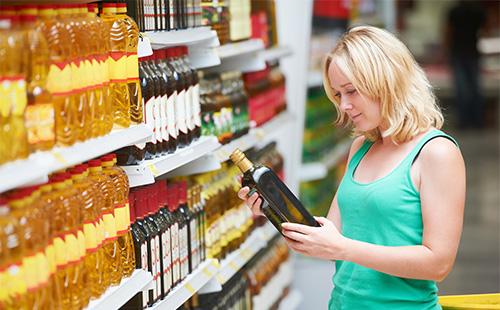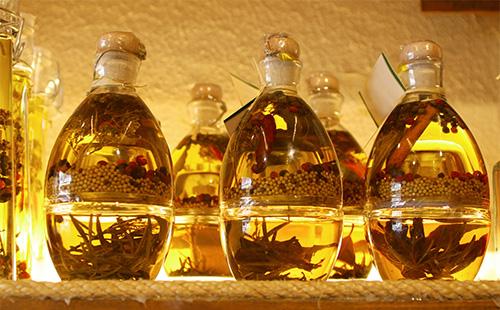The content of the article
The first who tasted olive oil were the ancient Egyptians. Later, the product was evaluated and began to produce in Asia Minor, Greece, Italy, Spain. Today, olive plantations are even in America. And everywhere the oil is different: in color, density, aroma, shade of taste. But everyone benefits.
If you are just going to discover a product such as olive oil, it will be important to find out the answers to the following questions: where to store olive oil, at what temperature is it stored, can it be stored directly in an iron can, how to store an open package with olive oil and how much can it be stored after opening without compromising on quality?
Composition and benefits
Olive juice consists of 99.8% fat, of which only 14.4% is saturated, and the rest are polyunsaturated (Omega-3 and Omega-6) and monounsaturated (Omega-9), that is, those that are exclusively brought to us favor. There are no harmful trans fats at all. And also as part of vitamins (A, D, E, K, group B), antioxidants. The table details the role of the components of olive oil.
Table - Composition and benefits of olive oil
| Substance | Benefit |
|---|---|
| Omega-6 (mainly linoleic acid) | - anti-inflammatory effect; - lowering cholesterol; - strengthening of blood vessels; - normalization of blood sugar; - strengthening of cartilage; - slowing down the aging process of tissues; - improvement of brain activity; - reducing the risk of oncology |
| Omega-9 (mainly oleic acid) | - Improving the work of the heart and blood vessels; - maintaining blood glucose levels; - strengthening immunity; - lowering cholesterol; - reducing the risk of oncology |
| Antioxidants (Polyphenols) | - Normalization of blood pressure; - maintaining normal heart function; - protection against free radicals; - prevention of atherosclerosis; - reducing the risk of developing oncology; - strengthening cell membranes; - improving the regenerative ability of cells |
| Vitamin A | - Strengthening immunity; - antioxidant effect; - participation in protein synthesis; - normalization of metabolic processes; - strengthening cell membranes; - protection of bone tissue from destruction |
| Vitamin E | - Decrease in blood sugar; - antioxidant effect; - prevention of Alzheimer's disease; - reducing the risk of developing oncology; - normalization of the hormonal background; - improvement of skin turgor; - strengthening the walls of blood vessels; - maintaining immune functions |
| Vitamin D | - Improving the absorption of calcium; - stimulation of cell growth and regeneration; - protection of nerve fibers; - synthesis of immune cells; - normalization of blood glucose |
| Vitamin K | - Growth and strengthening of bone tissue; - maintaining liver function; - increased blood coagulation; - neutralization of poisons and toxins |
| Choline (Vitamin B4) | - Strengthening cell membranes; - normalization of fat metabolism; - protection of nerve fibers; - stimulation of cell regeneration; - maintaining the functions of the liver and kidneys; - prevention of atherosclerosis; - normalization of blood sugar; - improvement of brain activity |
Main varieties
Take your time to buy a product with a lower price tag. Read the label carefully. Three main varieties can be distinguished depending on the degree of purification.
- Extra Virgin and Virgin. This is a premium grade unfiltered oil produced by cold pressing. That is, by simply pressing the fruit. A kind of "fresh" from olives. It has a rich aroma and astringent taste with a soft bitterness. The best use is in salads and sauces. Frying on it is wasteful and unprofitable, because it quickly begins to “burn” and secrete carcinogens.
- Refined. Refined oil. After filtration, the product loses its pronounced aroma and taste, as well as part of the fat. But when frying, it does not fade and is cheaper. But keep in mind: re-frying on it is not recommended, it is better to pour out the remaining oil immediately after cooking.
- Pomace. This oil is extracted from the extracts remaining after the production of Virgin Oil. Here, heat treatment of oilcake and various reagents are already in use. Accordingly, such a product does not have the nutritional value that we expect from “liquid gold”. You can fry on it (you can’t heat it twice!), But in salads and dressings it is not suitable at all: neither taste, nor aroma, nor benefit. Plus - low price.
4 tips for choosing a product
Regarding the choice of variety, it is important to understand exactly how you plan to use the oil. If you have in order to heat-treat products in a pan, it makes no sense to buy expensive Extra Virgin - you won’t get much benefit, but you can harm your health. In this case, it is better to opt for refined options. There are four more nuances that are worth paying attention to.
- Country of manufacture and bottling. The best quality product is one that is produced and bottled in one country (look for DOP on the label). If the oil was spilled not in the country where the raw materials were grown, then the label will show IGP. The faster the oil was packaged, the less it came into contact with the external environment and the more “utilities” were saved.
- Tara. Olive oil spoils in the light, so look for the product in dark glass. Another acceptable packaging option is a can. A self-respecting manufacturer will not spoil good oil with a clear plastic bottle.
- the date of bottling. The closer it is to the date of purchase, the better. Ideal when the purchase occurs within six months after packaging. The longer the oil travels to the counter, the more properties it loses.
- Shelf life. On average, it is one year. But some manufacturers point to the label for two years. In fact, with proper storage, packaged oil will not deteriorate during this time, but there will be little taste, aroma and benefit in it. Therefore, the rule is again relevant: the fresher, the better.

Storage rules after opening the bottle
And so, “liquid gold” was bought and delivered to the kitchen. Now its “usefulness” must be kept as carefully as possible - improper handling can ruin the product in a few days.
The timing
Even professional chefs argue about this. Some argue that after two to three weeks of use, the oil begins to rapidly lose its taste and benefit. In their opinion, it is possible to store the product in glass for only four weeks.Further use is at least useless, and as a maximum it can harm health.
Others claim that after a month of use, a quality product does not lose its organoleptic and other properties. And if the composition began to deteriorate, then you bought a fake.
Temperature
Olive oil likes to cool and it is desirable to store it at a temperature of about 15 ° C. The maximum value is 25 ° C. Heat is detrimental to the product. Hence the conclusion: to put a bottle near the stove, as we used to do with the same sunflower oil, is impossible. Otherwise, its contents will turn into a useless liquid.
A place
Keeping the product in the light, and even more so in the sun, means voluntarily spoiling the composition in a short time. Find a dark and cool place for him. This may be a cupboard with opaque doors, located away from the stove. Or a shelf in the pantry. You can arrange a place in the cellar.
There is also controversy over the storage of olive oil in the refrigerator.
- Behind. Some believe that you can not only store the composition in the refrigerator, but also freeze it. And even if the oil thickens and precipitates, everything is fixable. After a few hours at room temperature, it acquires its original appearance and consistency. The argument is: a refrigerator is the best way to preserve food. And while their nutritional value does not change. This means that the composition of olive oil will not suffer.
- Vs. According to other experts, low temperatures are harmful on a par with high. From the cold, the oil thickens, becomes cloudy and may even precipitate in the form of white flakes. In addition, irreversible chemical processes occur, as a result of which vitamins break down, a part of healthy fats is lost.

Tara
Oxygen is fatal to “liquid gold,” like high temperatures or light. Fats quickly oxidize and instead of a noble bitterness we get a rancid taste and an unpleasant odor.
If you bought olive oil in a glass bottle, then it is enough just to tightly cork the neck after each use. And you need to do this as soon as possible. And it is better to cast in small portions into separate containers. It is important that the neck is narrow so that you minimize the area of contact with oxygen. For these purposes, special small ceramic jugs are even sold in stores.
If, despite all the precautions, the oil has lost its organoleptic properties - do not rush to throw the bottle away. Residues can be used as part of masks for skin and hair.

